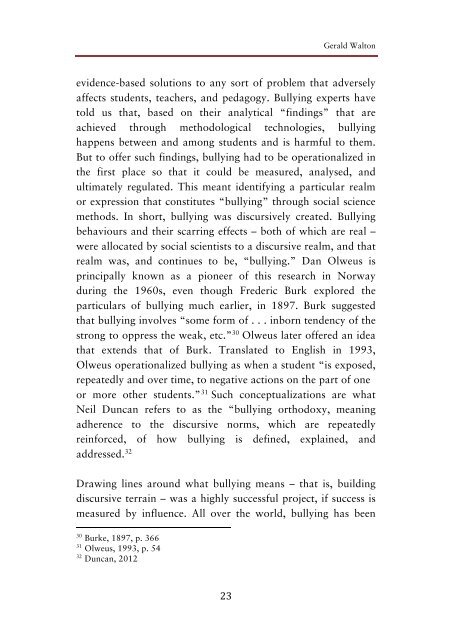Create successful ePaper yourself
Turn your PDF publications into a flip-book with our unique Google optimized e-Paper software.
Gerald Walton<br />
evidence-based solutions to any sort of problem that adversely<br />
affects students, teachers, and pedagogy. Bullying experts have<br />
told us that, based on their analytical “findings” that are<br />
achieved through methodological technologies, bullying<br />
happens between and among students and is harmful to them.<br />
But to offer such findings, bullying had to be operationalized in<br />
the first place so that it could be measured, analysed, and<br />
ultimately regulated. This meant identifying a particular realm<br />
or expression that constitutes “bullying” through social science<br />
methods. In short, bullying was discursively created. Bullying<br />
behaviours and their scarring effects – both of which are real –<br />
were allocated by social scientists to a discursive realm, and that<br />
realm was, and continues to be, “bullying.” Dan Olweus is<br />
principally known as a pioneer of this research in Norway<br />
during the 1960s, even though Frederic Burk explored the<br />
particulars of bullying much earlier, in 1897. Burk suggested<br />
that bullying involves “some form of . . . inborn tendency of the<br />
strong to oppress the weak, etc.” 30 Olweus later offered an idea<br />
that extends that of Burk. Translated to English in 1993,<br />
Olweus operationalized bullying as when a student “is exposed,<br />
repeatedly and over time, to negative actions on the part of one<br />
or more other students.” 31 Such conceptualizations are what<br />
Neil Duncan refers to as the “bullying orthodoxy, meaning<br />
adherence to the discursive norms, which are repeatedly<br />
reinforced, of how bullying is defined, explained, and<br />
addressed. 32<br />
Drawing lines around what bullying means – that is, building<br />
discursive terrain – was a highly successful project, if success is<br />
measured by influence. All over the world, bullying has been<br />
30<br />
Burke, 1897, p. 366<br />
31<br />
Olweus, 1993, p. 54<br />
32<br />
Duncan, 2012 <br />
23


